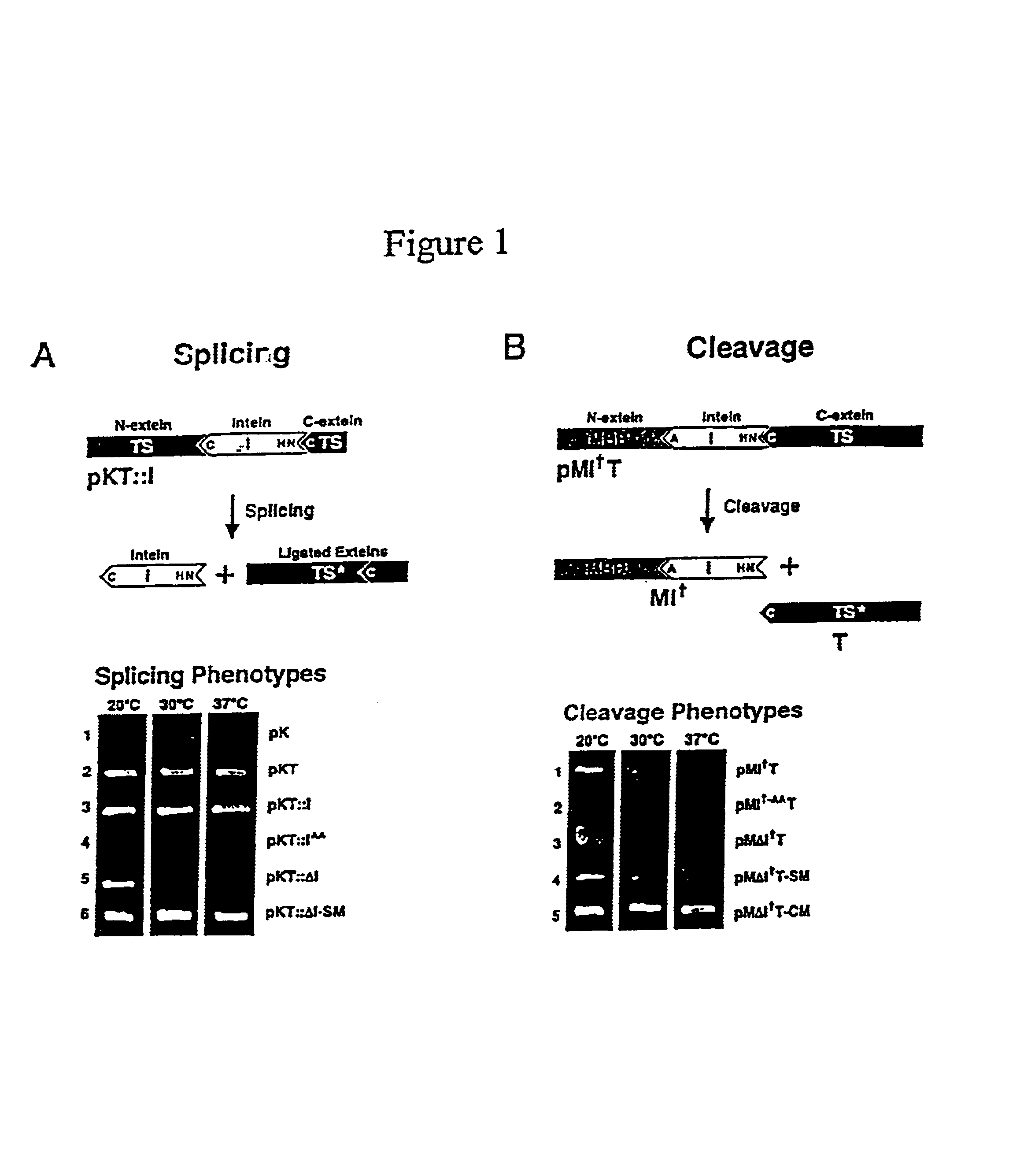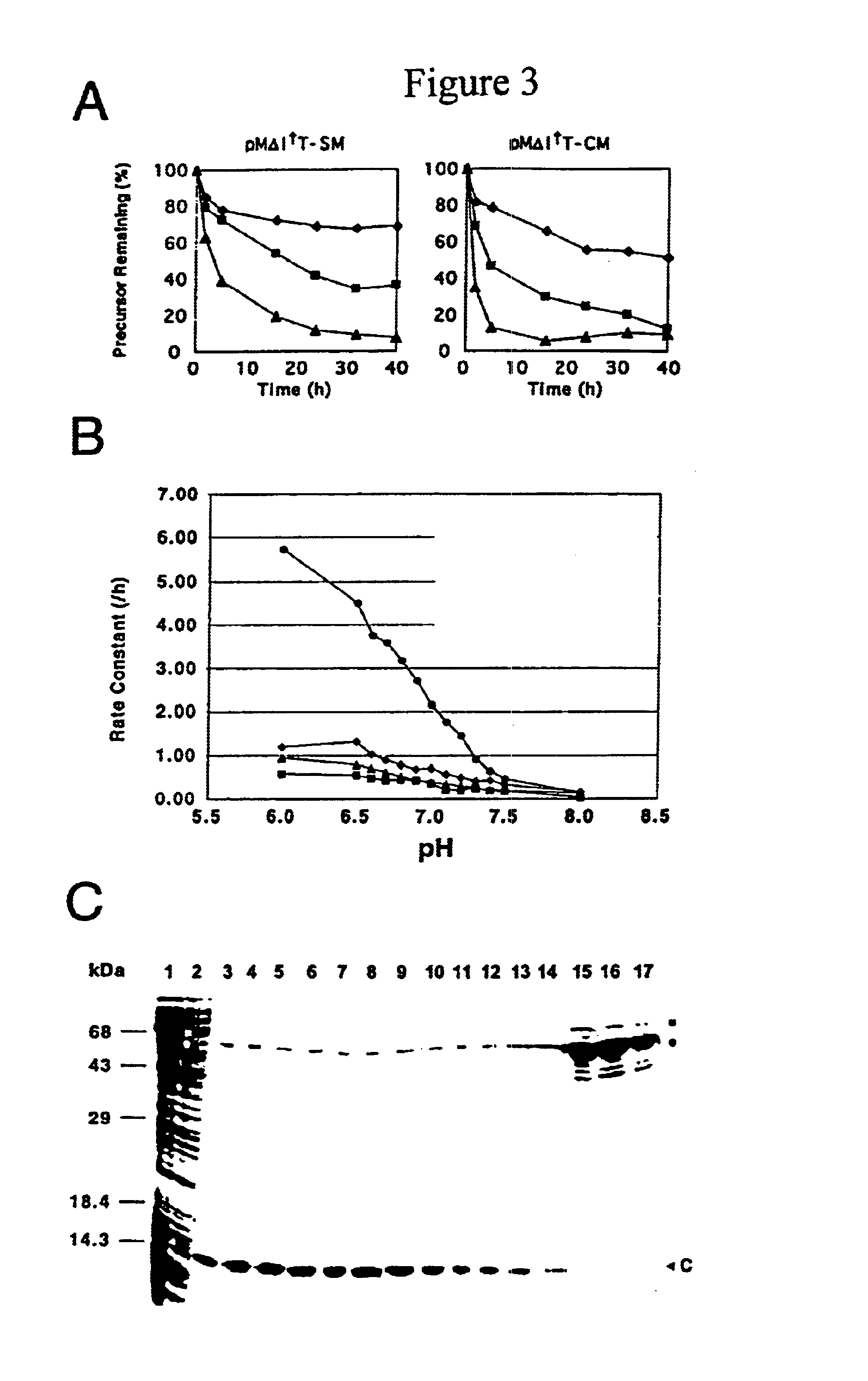Genetic system and self-cleaving inteins derived therefrom, bioseparations and protein purification employing same, and methods for determining critical, generalizable amino acid residues for varying intein activity
a technology of inteins and gene systems, applied in the direction of peptide/protein ingredients, transferases, peptide sources, etc., can solve the problems of compromising the purity and yield of desired products, their limitations preventing their wide use in large scale applications, and the potential of this technique for large-scale pharmaceutical production is limited
- Summary
- Abstract
- Description
- Claims
- Application Information
AI Technical Summary
Benefits of technology
Problems solved by technology
Method used
Image
Examples
example 1
Genetic System Yielding Self-Cleaving Inteins and Protein Purification with Same Experimental Protocol
[0126]Plasmid construction. Plasmid pK is pKK223-3 (Pharmacia) (Table 1). Plasmid pKT consists of the bacteriophage T4 td gene inserted into pK, while pKT::I contains the Mtu intein inserted N-terminal to Cys-238 such that TS sequence is restored by intein splicing. Derbyshire et al. (1997a). For cleavage selection, the intein and id genes were amplified separately by PCR and joined by overlap extension (SOEing) (Horton et al. (1990) BioTech. 8:528-536) to form IT fusion DNA with the external primers encoding the C1A mutation. This DNA was then cloned into pMal-c2 (New England Biolabs) to form pMIT. In both cases, inactive control inteins (superscript AA) were formed by replacing the conserved C-terminal His—Asn with Ala—Ala via PCR. The MΔI†C fusion was generated by replacing the id gene (T) in MΔI†T with C-I-TevI(C).
[0127]Generation and selection of mutant inteins. Inteins were am...
example 2
Purification of Toxic Proteins by Inactivation with Inteins in Specific Regions and pH-Controllable Intein Splicing
[0138]The fusion gene I-TevI::SM::CBD with the intein N-terminal to Cys164 was cloned into pET28a (Novagen), an expression vector with a strong T7 promoter. A non-spliceable control, I-TevI::SMAA, in which the His-Asn dipeptide at the C-terminus of the SM mini-intein was mutated to Ala—Ala, was also cloned into pET28a to test the toxicity of the unspliced precursor. When the plasmids were transformed into BL21 (DE3), an E. coli strain for expression of genes with T7 promoters (Studier et al. (1990), Met. Enzymol. 185:60-89) there were no transformants for pET28-I-TevI::SM::CBD but many transformants for pET28-I-TevI::SMAA. Restored toxicity suggested leaky expression of I-TevI. To reduce the leaky expression of 1-TevI::SM::CBD, the strain BL21 (DE3)pLysS was used, which has more stringent control over T7 polymerase by inhibiting its activity with T7 lysozyme expressed f...
example 3
Trimethoprim to Select for Inteins with Reduced Activity to Generate Controllable Intein Mutants
[0142]In the presence of trimethoprim and thymine, the effect on growth phenotype of liberated thymidylate synthase is reversed, leading to a loss of cell viability as a result of intein activity. This aspect of the screen has been used to generate full-length Mtu intein mutants with compromised activity at 37° C.
[0143]The use of trimethoprim can further be refined to provide a screen for evaluating variations in intein activity at different temperatures (see FIG. 6). As the activity of the intein and resulting thymidylate synthase increase, so does the cell sensitivity to trimethoprim. A series of agar plates, each containing a different concentration of trimethoprim is used to indicate variations in intein activity based on the drug sensitivity. This screen has been used to indicate relative activities of a number of intein mutants. This screen can also be used to gradually increase sel...
PUM
| Property | Measurement | Unit |
|---|---|---|
| pH | aaaaa | aaaaa |
| pH | aaaaa | aaaaa |
| temperatures | aaaaa | aaaaa |
Abstract
Description
Claims
Application Information
 Login to View More
Login to View More - R&D
- Intellectual Property
- Life Sciences
- Materials
- Tech Scout
- Unparalleled Data Quality
- Higher Quality Content
- 60% Fewer Hallucinations
Browse by: Latest US Patents, China's latest patents, Technical Efficacy Thesaurus, Application Domain, Technology Topic, Popular Technical Reports.
© 2025 PatSnap. All rights reserved.Legal|Privacy policy|Modern Slavery Act Transparency Statement|Sitemap|About US| Contact US: help@patsnap.com



